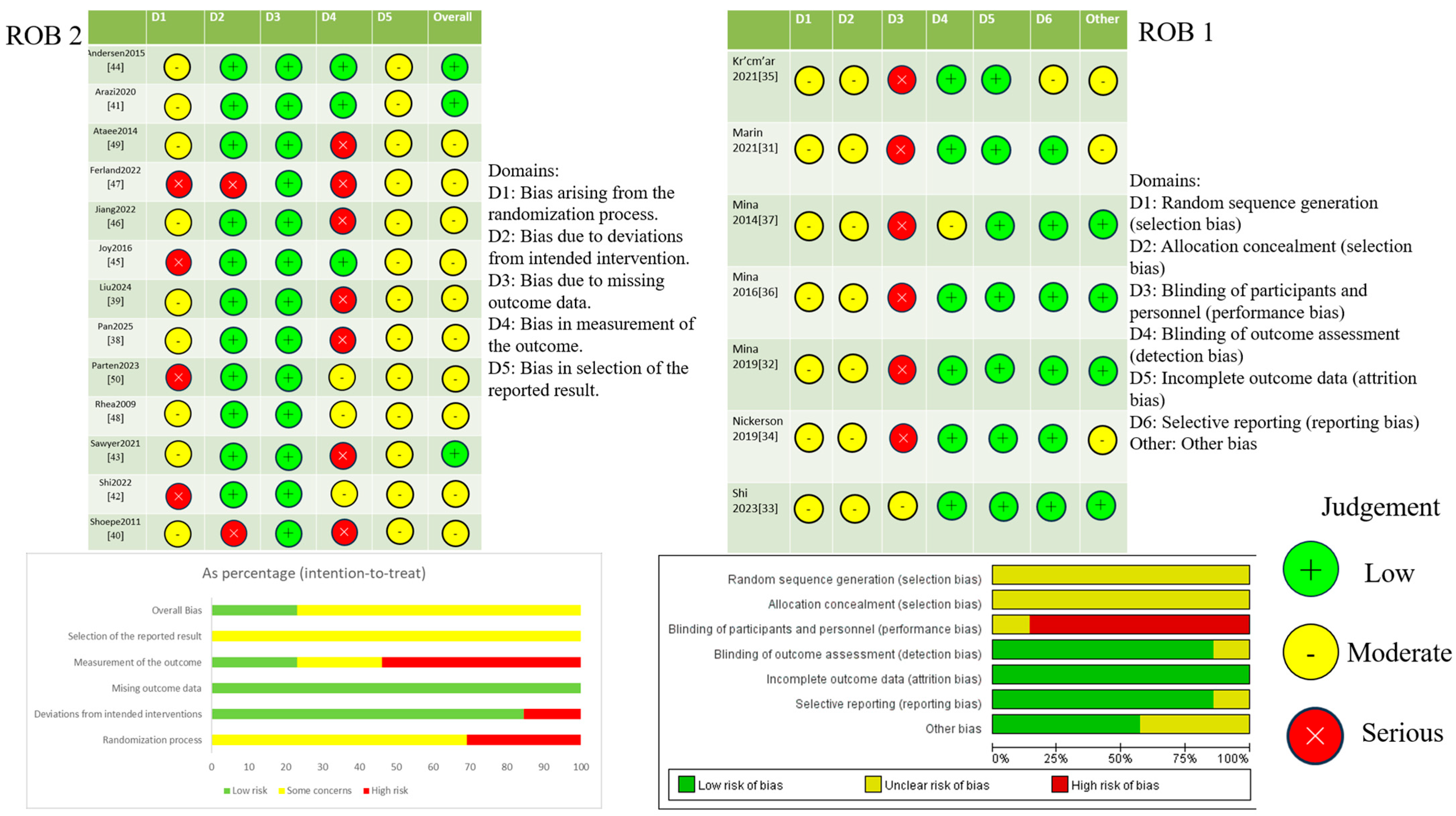Variable Versus Constant Resistance Squat Training for Lower-Limb Strength and Power: A Systematic Review and Meta-Analysis
Abstract
1. Introduction
2. Methods
2.1. Search Strategy and Information Sources
2.2. Eligibility Criteria and Study Selection
2.3. Data Extraction
2.4. Risk of Bias and Methodological Quality Assessment
2.5. Statistical Analysis
2.5.1. Effect Size Calculation
2.5.2. Meta-Analysis and Heterogeneity
2.5.3. Subgroup and Publication Bias Analyses
3. Results
3.1. Literature Search Results
3.2. Characteristics of Included Studies
3.3. Meta-Analysis of Intervention Effects
3.3.1. Acute Effects on Lower-Limb Strength Performance
3.3.2. Long-Term Effects on Lower-Limb Maximal Strength
3.3.3. Long-Term Effects on Lower-Limb Explosive Power
3.4. Methodological Quality and Risk of Bias
4. Discussion
4.1. Acute Performance Enhancement
4.2. Long-Term Adaptations to Variable Resistance
5. Limitations
6. Conclusions and Future Directions
Author Contributions
Funding
Institutional Review Board Statement
Informed Consent Statement
Data Availability Statement
Conflicts of Interest
Appendix A
Appendix A.1
| Author, Year | D1 | D2 | D3 | D4 | D5 | D6 | D7 | D8 | D9 | D10 | D11 | Total |
|---|---|---|---|---|---|---|---|---|---|---|---|---|
| Andersen, 2015 [44] | Y | 1 | 0 | 1 | 0 | 0 | 0 | 1 | 0 | 1 | 1 | 5 |
| Arazi, 2020 [41] | Y | 1 | 0 | 1 | 0 | 0 | 1 | 1 | 1 | 1 | 1 | 7 |
| Ataee, 2014 [49] | Y | 1 | 0 | 1 | 0 | 0 | 0 | 1 | 1 | 1 | 1 | 6 |
| Ferland, 2022 [47] | Y | 0 | 0 | 1 | 0 | 0 | 0 | 1 | 0 | 1 | 1 | 4 |
| Jiang, 2022 [46] | Y | 1 | 0 | 1 | 0 | 0 | 0 | 1 | 1 | 1 | 1 | 6 |
| Joy, 2016 [45] | Y | 0 | 0 | 1 | 0 | 0 | 1 | 1 | 1 | 1 | 1 | 6 |
| Krčmár, 2021 [35] | Y | 1 | 0 | 1 | 0 | 0 | 0 | 0 | 0 | 1 | 1 | 4 |
| Liu, 2024 [39] | Y | 1 | 0 | 1 | 0 | 0 | 0 | 1 | 1 | 1 | 1 | 6 |
| Marin, 2021 [31] | Y | 1 | 0 | 1 | 0 | 0 | 0 | 1 | 1 | 1 | 1 | 6 |
| Mina, 2014 [37] | Y | 1 | 0 | 1 | 0 | 0 | 0 | 1 | 1 | 1 | 1 | 6 |
| Mina, 2016 [36] | Y | 1 | 0 | 1 | 0 | 0 | 0 | 1 | 1 | 1 | 1 | 6 |
| Mina, 2019 [32] | Y | 1 | 0 | 1 | 0 | 0 | 0 | 0 | 0 | 1 | 1 | 4 |
| Nickerson, 2019 [34] | Y | 1 | 0 | 1 | 0 | 0 | 0 | 1 | 1 | 1 | 1 | 6 |
| Pan, 2025 [38] | Y | 1 | 0 | 1 | 0 | 0 | 0 | 1 | 0 | 1 | 1 | 5 |
| Parten, 2023 [50] | Y | 0 | 0 | 1 | 0 | 0 | 0 | 1 | 0 | 1 | 1 | 4 |
| Rhea, 2009 [48] | Y | 1 | 0 | 1 | 0 | 0 | 0 | 1 | 1 | 1 | 1 | 6 |
| Sawyer, 2021 [43] | Y | 1 | 0 | 1 | 0 | 0 | 0 | 1 | 0 | 1 | 1 | 5 |
| Shi, 2022 [42] | Y | 1 | 0 | 1 | 0 | 0 | 0 | 1 | 0 | 1 | 1 | 5 |
| Shi, 2023 [33] | Y | 1 | 0 | 1 | 0 | 0 | 0 | 1 | 0 | 1 | 1 | 5 |
| Shoepe, 2011 [40] | Y | 1 | 0 | 1 | 0 | 0 | 0 | 0 | 0 | 1 | 1 | 4 |
Appendix A.2
Appendix A.3
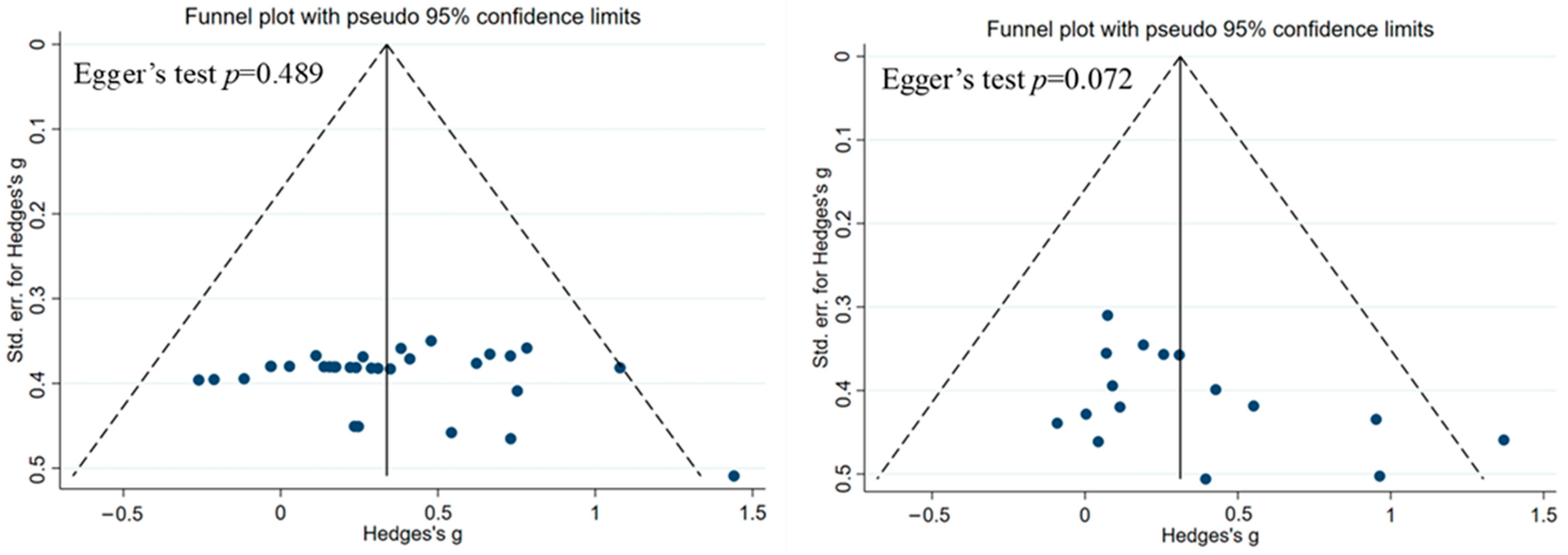
References
- Zatsiorsky, V.M.; Kraemer, W.J.; Fry, A.C. Science and Practice of Strength Training; Human Kinetics: Champaign, IL, USA, 2020. [Google Scholar]
- NSCA-National Strength Conditioning Association (Ed.) Essentials of Strength Training and Conditioning; Human Kinetics: Champaign, IL, USA, 2021. [Google Scholar]
- Suchomel, T.J.; Nimphius, S.; Bellon, C.R.; Stone, M.H. The importance of muscular strength: Training considerations. Sports Med. 2018, 48, 765–785. [Google Scholar] [CrossRef]
- de Salles Painelli, V. Risks and Recommendations for Resistance Training in Youth Athletes: A Narrative Review with Emphasis on Muscular Fitness and Hypertrophic Responses. J. Sci. Sport Exerc. 2023, 5, 1–16. [Google Scholar] [CrossRef]
- Rivière, M.; Louit, L.; Strokosch, A.; Seitz, L.B. Variable resistance training promotes greater strength and power adaptations than traditional resistance training in elite youth rugby league players. J. Strength Cond. Res. 2017, 31, 947–955. [Google Scholar] [CrossRef]
- Fuentes-García, M.A.; Malchrowicz-Mośko, E.; Castañeda-Babarro, A. Effects of variable resistance training versus conventional resistance training on muscle hypertrophy: A systematic review. Sport Sci. Health 2024, 20, 37–45. [Google Scholar] [CrossRef]
- Frost, D.M.; Cronin, J.; Newton, R.U. A biomechanical evaluation of resistance: Fundamental concepts for training and sports performance. Sports Med. 2010, 40, 303–326. [Google Scholar] [CrossRef] [PubMed]
- Stevenson, M.W.; Warpeha, J.M.; Dietz, C.C.; Giveans, R.M.; Erdman, A.G. Acute effects of elastic bands during the free-weight barbell back squat exercise on velocity, power, and force production. J. Strength Cond. Res. 2010, 24, 2944–2954. [Google Scholar] [CrossRef] [PubMed]
- Wallace, B.J.; Bergstrom, H.C.; Butterfield, T.A. Muscular bases and mechanisms of variable resistance training efficacy. Int. J. Sports Sci. Coach. 2018, 13, 1177–1188. [Google Scholar] [CrossRef]
- Anderson, C.E.; Sforzo, G.A.; Sigg, J.A. The effects of combining elastic and free weight resistance on strength and power in athletes. J. Strength Cond. Res. 2008, 22, 567–574. [Google Scholar] [CrossRef] [PubMed]
- García-López, D.; Hernández-Sánchez, S.; Martín, E.; Marín, P.J.; Zarzosa, F.; Herrero, A.J. Free-weight augmentation with elastic bands improves bench press kinematics in professional rugby players. J. Strength Cond. Res. 2016, 30, 2493–2499. [Google Scholar] [CrossRef]
- Liu, R.; Liu, J.; Clarke, C.V.; An, R. Effect of eccentric overload training on change of direction speed performance: A systematic review and meta-analysis. J. Sports Sci. 2020, 38, 2579–2587. [Google Scholar] [CrossRef]
- Baker, D.G.; Newton, R.U. Effect of kinetically altering a repetition via the use of chain resistance on velocity during the bench press. J. Strength Cond. Res. 2009, 23, 1941–1946. [Google Scholar] [CrossRef]
- Andersen, V.; Fimland, M.S.; Kolnes, M.K.; Jensen, S.; Laume, M.; Saeterbakken, A.H. Electromyographic comparison of squats using constant or variable resistance. J. Strength Cond. Res. 2016, 30, 3456–3463. [Google Scholar] [CrossRef]
- Lin, Y.; Xu, Y.; Hong, F.; Li, J.; Ye, W.; Korivi, M. Effects of variable-resistance training versus constant-resistance training on maximum strength: A systematic review and meta-analysis. Int. J. Environ. Res. Public Health 2022, 19, 8559. [Google Scholar] [CrossRef]
- Soria-Gila, M.A.; Chirosa, I.J.; Bautista, I.J.; Baena, S.; Chirosa, L.J. Effects of variable resistance training on maximal strength: A meta-analysis. J. Strength Cond. Res. 2015, 29, 3260–3270. [Google Scholar] [CrossRef]
- Shi, L.; Lyons, M.; Duncan, M.; Chen, S.; Chen, Z.; Guo, W.; Han, D. Effects of variable resistance training on strength performance: A systematic review and meta-analysis. J. Shanghai Univ. Sport 2022, 46, 90–104. [Google Scholar]
- Moher, D.; Liberati, A.; Tetzlaff, J.; Altman, D.G. Preferred reporting items for systematic reviews and meta-analyses: The PRISMA statement. BMJ 2009, 6, e1000097. [Google Scholar]
- McHugh, M.L. Interrater reliability: The kappa statistic. Biochem. Medica 2012, 22, 276–282. [Google Scholar] [CrossRef]
- Drevon, D.; Fursa, S.R.; Malcolm, A.L. Intercoder reliability and validity of WebPlotDigitizer in extracting graphed data. Behav. Modif. 2017, 41, 323–339. [Google Scholar] [CrossRef] [PubMed]
- Cohen, I.; Huang, Y.; Chen, J.; Benesty, J. Pearson correlation coefficient. In Noise Reduction in Speech Processing; Springer: Berlin/Heidelberg, Germany, 2009; pp. 1–4. [Google Scholar]
- Sterne, J.A.; Savović, J.; Page, M.J.; Elbers, R.G.; Blencowe, N.S.; Boutron, I.; Higgins, J.P. RoB 2: A revised tool for assessing risk of bias in randomised trials. BMJ 2019, 366, l4898. [Google Scholar] [CrossRef]
- Higgins, J.P.; Altman, D.G.; Gøtzsche, P.C.; Jüni, P.; Moher, D.; Oxman, A.D.; Sterne, J.A. The Cochrane Collaboration’s tool for assessing risk of bias in randomised trials. BMJ 2011, 343, d5928. [Google Scholar] [CrossRef]
- De Morton, N.A. The PEDro scale is a valid measure of the methodological quality of clinical trials: A demographic study. Aust. J. Physiother. 2009, 55, 129–133. [Google Scholar] [CrossRef]
- Thomas, J.R.; French, K.E. The use of meta-analysis in exercise and sport: A tutorial. Res. Q. Exerc. Sport 1986, 57, 196–204. [Google Scholar] [CrossRef]
- Elbourne, D.R.; Altman, D.G.; Higgins, J.P.; Curtin, F.; Worthington, H.V.; Vail, A. Meta-analyses involving cross-over trials: Methodological issues. Int. J. Epidemiol. 2002, 31, 140–149. [Google Scholar] [CrossRef]
- Hedges, L.V.; Olkin, I. Statistical Methods for Meta-Analysis; Academic Press: Cambridge, MA, USA, 2014. [Google Scholar]
- Hopkins, W.; Marshall, S.; Batterham, A.; Hanin, J. Progressive statistics for studies in sports medicine and exercise science. Med. Sci. Sports Exerc. 2009, 41, 3–12. [Google Scholar] [CrossRef]
- Peters, J.L.; Sutton, A.J.; Jones, D.R.; Abrams, K.R.; Rushton, L. Contour-enhanced meta-analysis funnel plots help distinguish publication bias from other causes of asymmetry. J. Clin. Epidemiol. 2008, 61, 991–996. [Google Scholar] [CrossRef]
- Sterne, J.A.; Sutton, A.J.; Ioannidis, J.P.; Terrin, N.; Jones, D.R.; Lau, J.; Higgins, J.P. Recommendations for examining and interpreting funnel plot asymmetry in meta-analyses of randomised controlled trials. BMJ 2011, 343, d4002. [Google Scholar] [CrossRef] [PubMed]
- Marin, D.P.; Astorino, T.A.; Serafim, A.I.S.; Urtado, C.B.; Prestes, J.; Polito, L.F.T.; Otton, R. Comparison between traditional resistance exercise and variable resistance with elastic bands in acute vertical jump performance. Hum. Mov. 2021, 22, 28–35. [Google Scholar] [CrossRef]
- Mina, M.A.; Blazevich, A.J.; Tsatalas, T.; Giakas, G.; Seitz, L.B.; Kay, A.D. Variable, but not free-weight, resistance back squat exercise potentiates jump performance following a comprehensive task-specific warm-up. Scand. J. Med. Sci. Sports 2019, 29, 380–392. [Google Scholar] [CrossRef] [PubMed]
- Shi, L.; Ye, X.; Han, D.; Yang, C.; Tu, Y. Acute effects of back squat combined with different elastic band resistance on vertical jump performance in collegiate basketball players. J. Sports Sci. Med. 2023, 22, 502. [Google Scholar] [CrossRef] [PubMed]
- Nickerson, B.S.; Williams, T.D.; Snarr, R.L.; Park, K.S. Individual and combined effect of inter-repetition rest and elastic bands on jumping potentiation in resistance-trained men. J. Strength Cond. Res. 2019, 33, 2087–2093. [Google Scholar] [CrossRef]
- Krčmár, M.; Krčmárová, B.; Bakaľár, I.; Šimonek, J. Acute performance enhancement following squats combined with elastic bands on short sprint and vertical jump height in female athletes. J. Strength Cond. Res. 2021, 35, 318–324. [Google Scholar] [CrossRef]
- Mina, M.A.; Blazevich, A.J.; Giakas, G.; Seitz, L.B.; Kay, A.D. Chain-loaded variable resistance warm-up improves free-weight maximal back squat performance. Eur. J. Sport Sci. 2016, 16, 932–939. [Google Scholar] [CrossRef] [PubMed]
- Mina, M.A.; Blazevich, A.J.; Giakas, G.; Kay, A.D. Influence of variable resistance loading on subsequent free weight maximal back squat performance. J. Strength Cond. Res. 2014, 28, 2988–2995. [Google Scholar] [CrossRef]
- Pan, C.; Li, W.; Su, Y.; Shi, Y. Effects of variable resistance training with different load ratios on lower-limb strength and power in male college students. J. Exerc. Sci. Fit. 2025, 23, 181–189. [Google Scholar] [CrossRef]
- Liu, Y.; Huang, Z.; Zhou, Z.; Zhang, L.; Guo, Y.; Chen, C. Effects of variable resistance training within complex training on strength and punch performance in elite amateur boxers. Front. Physiol. 2024, 15, 1472258. [Google Scholar] [CrossRef] [PubMed]
- Shoepe, T.C.; Ramirez, D.A.; Rovetti, R.J.; Kohler, D.R.; Almstedt, H.C. The effects of 24 weeks of resistance training with simultaneous elastic and free weight loading on muscular performance of novice lifters. J. Hum. Kinet. 2011, 29, 93. [Google Scholar] [CrossRef]
- Arazi, H.; Salek, L.; Nikfal, E.; Izadi, M.; Tufano, J.J.; Elliott, B.T.; Brughelli, M. Comparable endocrine and neuromuscular adaptations to variable vs. constant gravity-dependent resistance training among young women. J. Transl. Med. 2020, 18, 239. [Google Scholar] [CrossRef] [PubMed]
- Shi, L.; Lyons, M.; Duncan, M.; Chen, S.; Chen, Z.; Guo, W.; Han, D. Effects of variable resistance training within complex training on neuromuscular adaptations in collegiate basketball players. J. Hum. Kinet. 2022, 84, 174. [Google Scholar] [CrossRef]
- Sawyer, J.; Higgins, P.; Cacolice, P.A.; Doming, T. Bilateral back squat strength is increased during a 3-week undulating resistance training program with and without variable resistance in DIII collegiate football players. PeerJ 2021, 9, e12189. [Google Scholar] [CrossRef]
- Andersen, V.; Fimland, M.S.; Kolnes, M.K.; Saeterbakken, A.H. Elastic bands in combination with free weights in strength training: Neuromuscular effects. J. Strength Cond. Res. 2015, 29, 2932–2940. [Google Scholar] [CrossRef]
- Joy, J.M.; Lowery, R.P.; de Souza, E.O.; Wilson, J.M. Elastic bands as a component of periodized resistance training. J. Strength Cond. Res. 2016, 30, 2100–2106. [Google Scholar] [CrossRef] [PubMed]
- Jiang, D.; Xu, G. Effects of chains squat training with different chain load ratio on the explosive strength of young basketball players’ lower limbs. Front. Physiol. 2022, 13, 979367. [Google Scholar] [CrossRef]
- Ferland, P.M.; Tremblay, N.; Allisse, M.; Comtois, A.S.; Bui, H.T.; Leone, M. The accommodated resistance training method significantly improves deadlift relative maximal strength more than the classic plate loaded method in male classic powerlifters. Gazz. Medica Ital.-Arch. Per Le Sci. Mediche 2022, 181, 507–515. [Google Scholar] [CrossRef]
- Rhea, M.R.; Kenn, J.G.; Dermody, B.M. Alterations in speed of squat movement and the use of accommodated resistance among college athletes training for power. J. Strength Cond. Res. 2009, 23, 2645–2650. [Google Scholar] [CrossRef]
- Ataee, J.; Koozehchian, M.S.; Kreider, R.B.; Zuo, L. Effectiveness of accommodation and constant resistance training on maximal strength and power in trained athletes. PeerJ 2014, 2, e441. [Google Scholar] [CrossRef] [PubMed]
- Parten, A.L.; Barker, G.A.; O’Neal, E.K.; Waldman, H.S. Seven-Week Accommodating Resistance Training Improves Wingate Peak Power But Not Muscular Strength or Endurance in Strength-Trained Females. J. Strength Cond. Res. 2023, 37, 1789–1794. [Google Scholar] [CrossRef]
- Blazevich, A.J.; Babault, N. Post-activation potentiation versus post-activation performance enhancement in humans: Historical perspective, underlying mechanisms, and current issues. Front. Physiol. 2019, 10, 1359. [Google Scholar] [CrossRef]
- Chen, L.; Lim, J.; Thapa, R.K.; Smk, H. Effects of deadlift vs. Back squat as post-activation performance enhancement protocols on vertical jump performance of competitive male basketball players. J. Sci. Sport Exerc. 2024, 6, 1–10. [Google Scholar] [CrossRef]
- Lum, D.; Howatson, G. Comparing the acute effects of a session of isometric strength training with heavy resistance training on neuromuscular function. J. Sci. Sport Exerc. 2023, 7, 40–49. [Google Scholar] [CrossRef]
- Pauli, P.H.; de Borba, E.F.; da Silva, M.P.; Martins, M.V.S.; Batista, M.M.; Tartaruga, M.P. Effects of Complex and contrast training on Strength, Power, and agility in Professional Futsal players: A preliminary study. J. Sci. Sport Exerc. 2024, 6, 378–385. [Google Scholar] [CrossRef]
- Panteli, N.; Hadjicharalambous, M.; Zaras, N. Delayed potentiation effect on sprint, power and agility performance in well-trained soccer players. J. Sci. Sport Exerc. 2024, 6, 131–139. [Google Scholar] [CrossRef]
- Masel, S.; Maciejczyk, M. Accommodating resistance is more effective than free weight resistance to induce post-activation performance enhancement in squat jump performance after a short rest interval. J. Exerc. Sci. Fit. 2024, 22, 59–65. [Google Scholar] [CrossRef]
- Scott, D.J.; Ditroilo, M.; Marshall, P. Effect of accommodating resistance on the postactivation potentiation response in rugby league players. J. Strength Cond. Res. 2018, 32, 2510–2520. [Google Scholar] [CrossRef]
- Liu, R.; Liu, J.; Ma, X.; Li, Q.; An, R. Effect of FIFA 11+ intervention on change of direction performance in soccer and futsal players: A systematic review and meta-analysis. Int. J. Sports Sci. Coach. 2021, 16, 862–872. [Google Scholar] [CrossRef]
- Tillin, N.A.; Bishop, D. Factors modulating post-activation potentiation and its effect on performance of subsequent explosive activities. Sports Med. 2009, 39, 147–166. [Google Scholar] [CrossRef]
- McMaster, D.T.; Cronin, J.; McGuigan, M. Forms of variable resistance training. Strength Cond. J. 2009, 31, 50–64. [Google Scholar] [CrossRef]
- Israetel, M.A.; McBride, J.M.; Nuzzo, J.L.; Skinner, J.W.; Dayne, A.M. Kinetic and kinematic differences between squats performed with and without elastic bands. J. Strength Cond. Res. 2010, 24, 190–194. [Google Scholar] [CrossRef]
- Hakkinen, K. Effect of combined concentric and eccentric strength training and detraining on force-time, muscle fiber and metabolic characteristics of leg extensor muscles. Scand. J. Sports Sci. 1981, 3, 50–58. [Google Scholar]
- Ebben, W.P.; Jensen, R.L. Electromyographic and kinetic analysis of traditional, chain, and elastic band squats. J. Strength Cond. Res. 2002, 16, 547–550. [Google Scholar] [PubMed]
- Behm, D.G.; Anderson, K.G. The role of instability with resistance training. J. Strength Cond. Res. 2006, 20, 716–722. [Google Scholar] [PubMed]
- Morin, J.B.; Edouard, P.; Samozino, P. Technical ability of force application as a determinant factor of sprint performance. Med. Sci. Sports Exerc. 2011, 43, 1680–1688. [Google Scholar] [CrossRef] [PubMed]

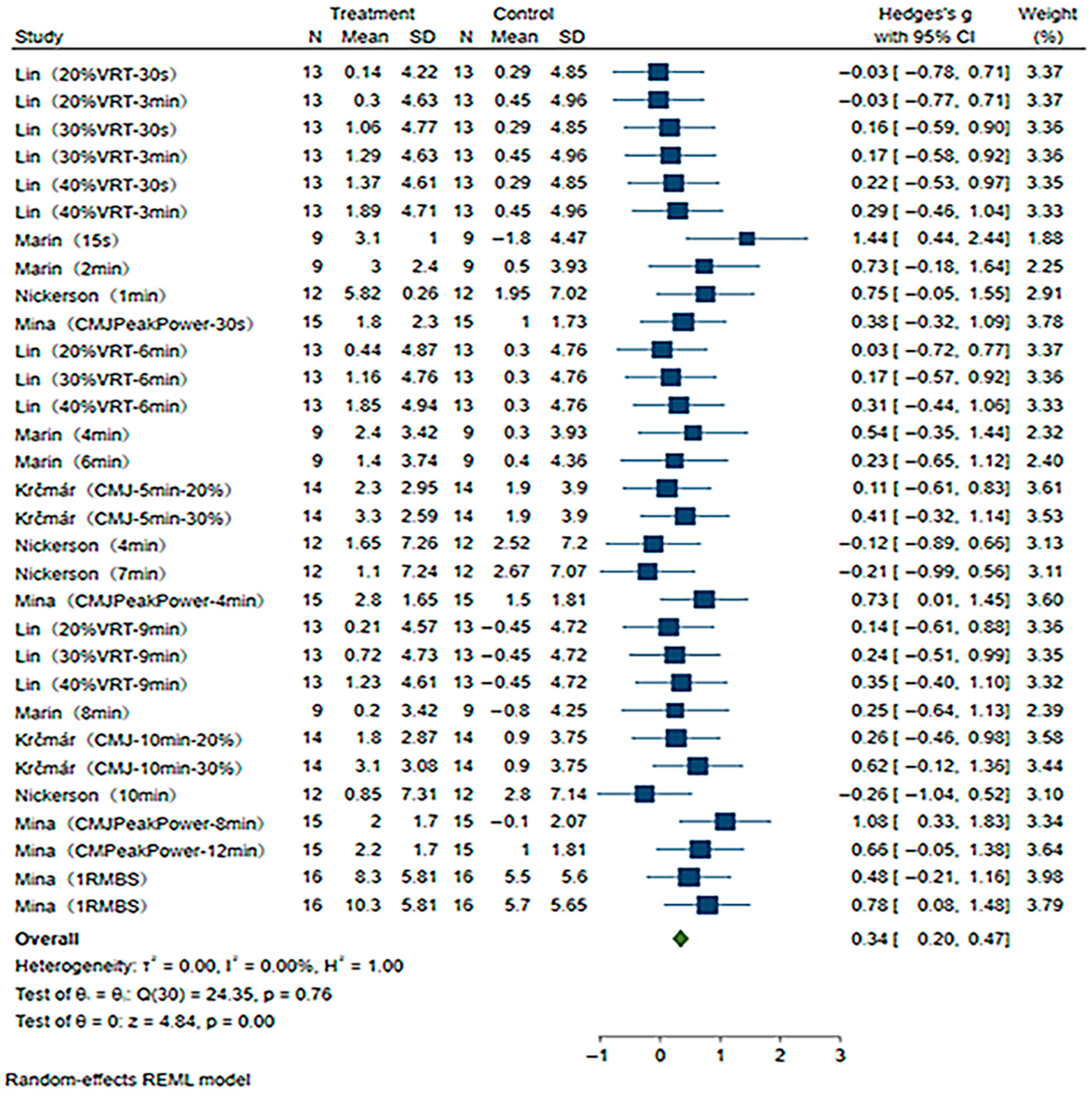
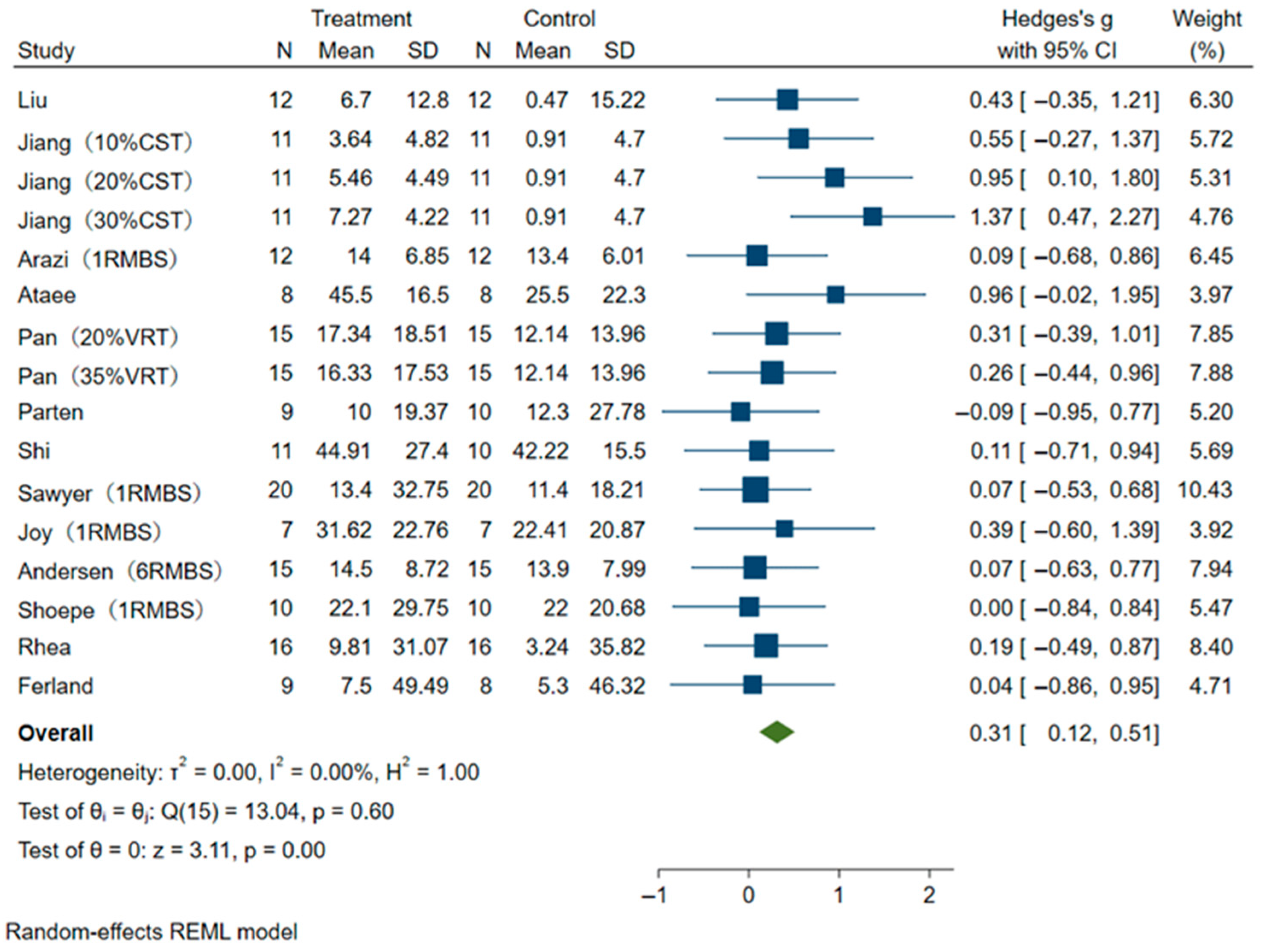
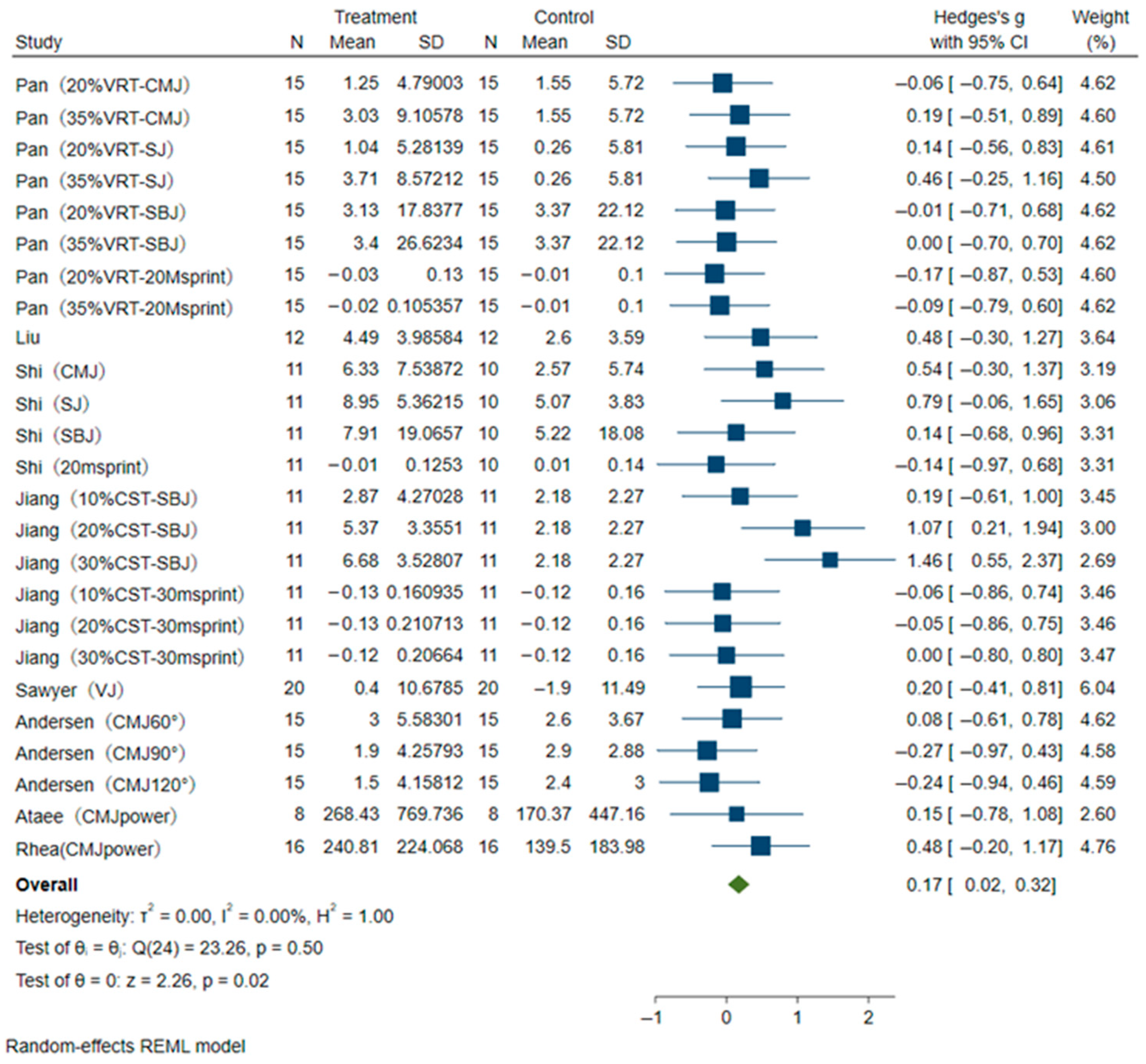
| Author/Year | Sample Size | Age (years) | Sex | Training Background | Variable Resistance Equipment | Training Type | Sets × Reps | CRT Intensity/1RM | VRT Intensity/1RM | Outcome Measures |
|---|---|---|---|---|---|---|---|---|---|---|
| Shi/2023 [33] | 13 | 20.5 ± 0.9 | Male | University Basketball Players | Elastic Bands | Squat | 1 × 3 | 85% | 85% + 20%/30%/40% | CMJ |
| Marin/2021 [31] | 9 | 21.4 ± 2.1 | Male | Elite Baseball Players | Elastic Bands | Squat | 3 × 5 | 85% | 55% + 30% | CMJ |
| Krčmár/2021 [35] | 14 | 21.9 ± 2.3 | Female | Athletes | Elastic Bands | Squat | 3 × 4 | 85% | 60% + 20% 50% + 30% | CMJ |
| Nickerson/2019 [34] | 12 | 22 ± 3 | Male | Strength-Trained Individuals | Elastic Bands | Squat | 1 × 3 | 85% | 71% + 14% | CMJ |
| Mina/2019 [32] | 15 | 21.7 ± 1.1 | Male | Five years high-intensity resistance training experience | Elastic Bands | Squat | 1 × 3 | 85% | 50% + 35% | CMJ PP |
| Mina/2016 [36] | 16 | 26 ± 7.8 | Male | Recreationally Trained | Chains | Squat | 2 × 3 | 85% | 70% + 30% | 1RM Squat |
| Mina/2014 [37] | 16 | 26 ± 7.8 | Male | Recreationally Trained | Elastic Bands | Squat | 2 × 3 | 85% | 70% + 30% | 1RM Squat |
| Author/Year | Sample Size | Age (Years) | Sex | Training Background | Variable Resistance Equipment | Training Type | Frequency/Week | Training Period (Weeks) | CRT Intensity/1RM | VRT Intensity/1RM | Outcome Measures |
|---|---|---|---|---|---|---|---|---|---|---|---|
| Pan/2025 [38] | 30 | 22 | Male | University Students | Elastic Bands | Squat | 2 | 6 | 80% | 64% + 20%52% + 35% | 1RM Squat, CMJ, SJ, 20 m Sprint |
| Liu/2024 [39] | 24 | 25 | Female | Elite Boxers | Chains | Squat | 1 | 6 | 85% | 65–70% + 15–20% | 1RM Squat, CMJ |
| Parten/2023 [50] | 19 | 20 | Female | Strength-Trained | Elastic Bands | Squat | 2 | 7 | 80–85% | 60–65% + 20% | 1RM Squat |
| Ferland/2022 [47] | 17 | 17–42 | Male | Weightlifters | Chains + Elastic Bands | Squat | 2 | 9 | 80% | 80% + 25% | 1RM Squat |
| Shi/2022 [42] | 21 | 21 | Male | University Basketball Players | Elastic Bands | Squat | 2 | 8 | 80–90% | Not Reported + 17% | 1RM Squat, CMJ, SJ, SBJ, 20 m Sprint |
| Jiang/2022 [46] | 44 | 15.48 ± 0.81 | Male | Basketball Players | Chains | Squat | 2 | 6 | 85% | 10% VR + 90% CR 20% VR + 80% CR 30% VR + 70% CR | 1RM Squat, 30 m Sprint |
| Sawrer/2021 [43] | 40 | 18–25 | Male | Rugby Players | Elastic Bands | Squat | 3 | 3 | 50–93% | Not Reported + 20% | 1RM Squat, VJ |
| Arazi/2020 [41] | 24 | 24 | Female | Untrained | Chains | Squat | 3 | 8 | 65–80% | 50–65% + 15% | 1RM Squat |
| Joy/2016 [45] | 14 | 21 | Male | NCAA D II Basketball Players | Elastic Bands | Squat | 1 | 5 | 40–95% | 25–80% + 30% | 1RM Squat, CMJ |
| Andersen/2015 [44] | 30 | 20–44 | Female | Healthy Females | Elastic Bands | Squat | 2 | 10 | 75–85% | Not Reported + 32–44% | 1RM Squat |
| Ataee/2014 [49] | 16 | 20 | Male | Strength-Trained | Chains | Squat | 3 | 4 | 85% | 80% + 20% | 1RM Squat |
| Shoepe/2011 [40] | 20 | 19–21 | Male/Female | University Students | Elastic Bands | Squat | 3 | 24 | 67–95% | Not Reported + 20–35% | 1RM Squat |
| Rhea/2009 [48] | 32 | 21 | Male | University Students | Elastic Bands | Squat | 2 | 12 | 75–85% | Not Reported | 1RM Squat |
| Subgroup | Moderator | No. of Comparisons (k) | Hedges’ g | 95% CI | p-Value | Heterogeneity | |
|---|---|---|---|---|---|---|---|
| I2 | p-Value | ||||||
| Recovery Time | 0–3 min | 10 | 0.27 | [0.01, 0.53] | 0.045 | 0 | 0.89 |
| 4–7 min | 10 | 0.22 | [−0.03, 0.47] | 0.086 | 0 | 0.86 | |
| 8–12 min | 11 | 0.43 | [0.20, 0.67] | <0.001 | 0 | 0.93 | |
| Subgroup | Moderator | No. of Comparisons (k) | Hedges’ g | 95%CI | p-Value | Heterogeneity | |
|---|---|---|---|---|---|---|---|
| I2 | p-Value | ||||||
| Intervention Type | Elastic Bands | 9 | 0.67 | [0.31, 1.03] | <0.001 | 4.1 | 0.39 |
| Chains | 6 | 0.15 | [−0.11, 0.40] | 0.266 | 0 | 0.64 | |
| Chains + Elastic Bands | 1 | N/A | N/A | N/A | N/A | N/A | |
| Intervention Duration | <8 week | 10 | 0.44 | [0.18, 0.70] | 0.001 | 0.4 | 0.43 |
Training Status Sex Training Frequency | ≥8 week Trained Untrained Male Female Mixed ≤2/week >2/week | 6 14 2 11 4 1 8 8 | 0.09 0.35 0.05 0.41 0.13 N/A 0.45 0.17 | [−0.23, 0.42] [0.14, 0.56] [−0.05, 0.62] [0.17, 0.64] [−0.26, 0.51] N/A [0.18, 0.72] [−0.12, 0.45] | 0.572 0.001 0.862 0.001 0.510 N/A 0.001 0.247 | 0 0 0 2.16 0 N/A 8.38 0 | 0.69 0.52 0.88 0.42 0.84 N/A 0.37 0.84 |
| Subgroup | Moderator | No. of Comparisons (k) | Hedges’ g | 95% CI | p-Value | Heterogeneity | |
|---|---|---|---|---|---|---|---|
| I2 | p-Value | ||||||
| Intervention Type | Elastic Bands | 17 | 0.10 | [−0.08, 0.28] | 0.26 | 0 | 0.92 |
| Chains | 8 | 0.37 | [0.06, 0.67] | 0.019 | 32.8 | 0.17 | |
| Intervention Duration | <8 week | 17 | 0.18 | [−0.00, 0.37] | 0.054 | 0 | 0.54 |
Outcome Type | ≥8 week Vertical Jump Horizontal Jump Sprint | 8 13 6 6 | 0.14 0.20 0.38 −0.09 | [−0.14, 0.42] [0.00, 0.40] [0.06, 0.70] [−0.40, 0.22] | 0.324 0.05 0.02 0.568 | 0 0 53.42 0 | 0.48 0.783 0.057 1 |
Disclaimer/Publisher’s Note: The statements, opinions and data contained in all publications are solely those of the individual author(s) and contributor(s) and not of MDPI and/or the editor(s). MDPI and/or the editor(s) disclaim responsibility for any injury to people or property resulting from any ideas, methods, instructions or products referred to in the content. |
© 2025 by the authors. Licensee MDPI, Basel, Switzerland. This article is an open access article distributed under the terms and conditions of the Creative Commons Attribution (CC BY) license (https://creativecommons.org/licenses/by/4.0/).
Share and Cite
Yan, Z.; Wu, J.; Lin, S.; Li, Q.; Liu, R. Variable Versus Constant Resistance Squat Training for Lower-Limb Strength and Power: A Systematic Review and Meta-Analysis. Appl. Sci. 2025, 15, 9144. https://doi.org/10.3390/app15169144
Yan Z, Wu J, Lin S, Li Q, Liu R. Variable Versus Constant Resistance Squat Training for Lower-Limb Strength and Power: A Systematic Review and Meta-Analysis. Applied Sciences. 2025; 15(16):9144. https://doi.org/10.3390/app15169144
Chicago/Turabian StyleYan, Zhijie, Juncheng Wu, Shengfa Lin, Qi Li, and Ruidong Liu. 2025. "Variable Versus Constant Resistance Squat Training for Lower-Limb Strength and Power: A Systematic Review and Meta-Analysis" Applied Sciences 15, no. 16: 9144. https://doi.org/10.3390/app15169144
APA StyleYan, Z., Wu, J., Lin, S., Li, Q., & Liu, R. (2025). Variable Versus Constant Resistance Squat Training for Lower-Limb Strength and Power: A Systematic Review and Meta-Analysis. Applied Sciences, 15(16), 9144. https://doi.org/10.3390/app15169144






